Top 20 destination in Turkey
Turkey, a country steeped in rich history, culture, and breathtaking landscapes, offers an extensive list of unforgettable destinations. From the bustling streets of Istanbul to the surreal landscapes of Cappadocia, from the archaeological wonders of Ephesus to the turquoise waters of the Mediterranean, there's something for every type of traveler. Here, we bring you the top 20 destinations to visit in Turkey:
Table of Contents
Istanbul
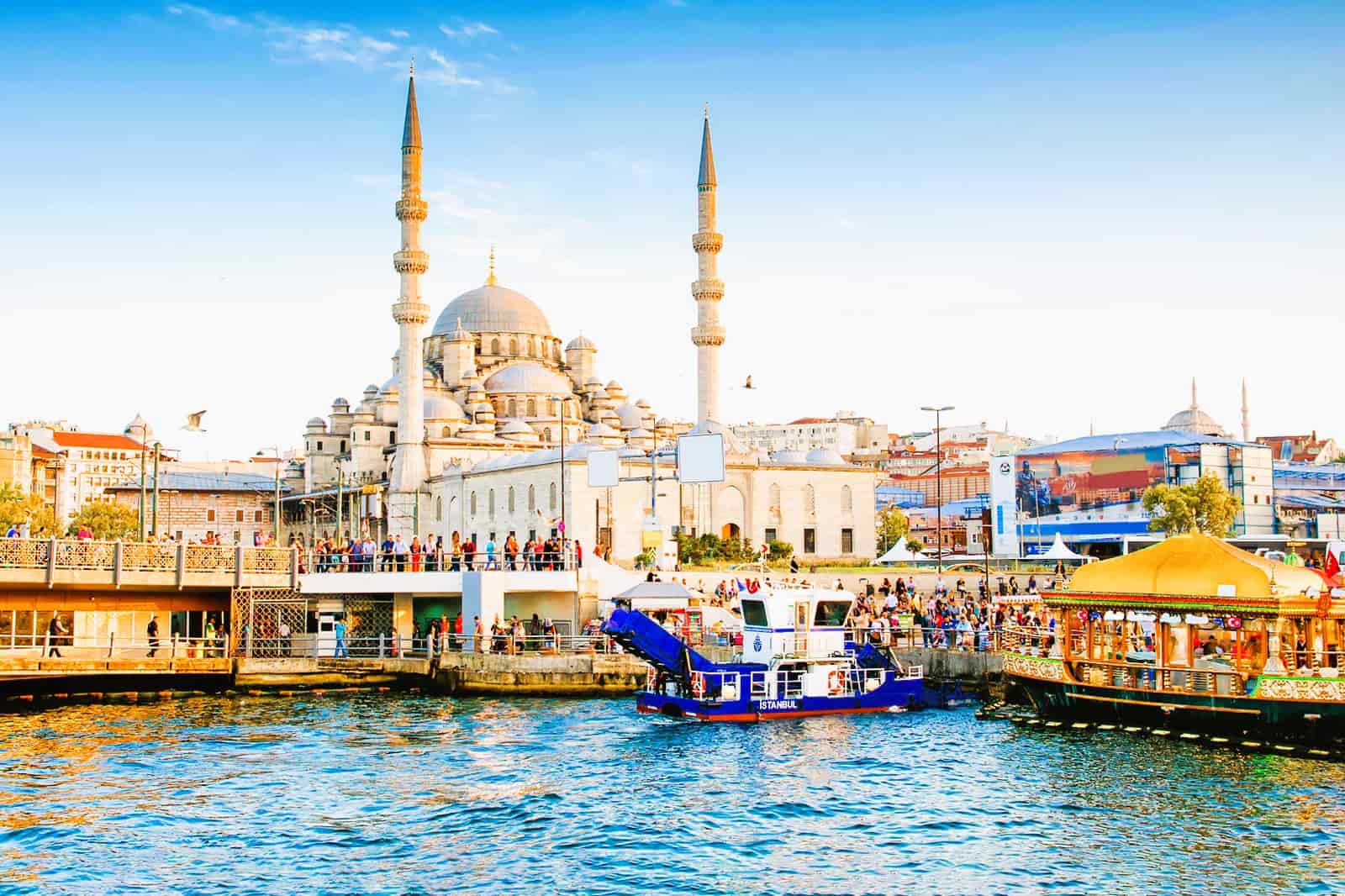
Istanbul is a city of contrasts, where East meets West and old meets new. It is a city with a rich history and culture, and it is home to some of the most iconic landmarks in the world.
Istanbul was founded by the ancient Greeks in the 7th century BC, and it has been a major city ever since. It was the capital of the Roman Empire, the Byzantine Empire, and the Ottoman Empire. Today, Istanbul is the largest city in Turkey, and it is a major centre for business, culture, and tourism.
Istanbul is home to many UNESCO World Heritage Sites, including the Hagia Sophia, the Blue Mosque, and the Topkapi Palace. These landmarks are just a few of the many things that make Istanbul a must-see destination.
In addition to its history and culture, Istanbul is also a great place to enjoy the outdoors. The city is located on the Bosphorus Strait, and it offers stunning views of the sea and the surrounding mountains. There are also many parks and gardens in Istanbul, where you can relax and enjoy the fresh air.
Istanbul is a city that has something to offer everyone. Whether you are interested in history, culture, food, or the outdoors, you will find it in Istanbul. So what are you waiting for? Start planning your trip today!
Cappadocia

Cappadocia is a region in central Turkey that is known for its unique landscape of fairy chimneys and rock formations. The region is also home to a number of historical and cultural sites, including the Goreme Open-Air Museum and the Uchisar Castle.
Cappadocia was formed by volcanic eruptions millions of years ago. The soft volcanic rock was eroded by wind and water, creating the distinctive fairy chimneys and rock formations that are found in the region.
The first people to live in Cappadocia were the Hittites, who arrived in the region around 1800 BC. The Hittites were followed by the Greeks, Romans, Byzantines, and Ottomans. Each of these civilizations left their mark on Cappadocia, and the region is home to a number of historical and cultural sites.
The Goreme Open-Air Museum is one of the most popular tourist destinations in Cappadocia. The museum is home to a number of rock-cut churches and monasteries that were built between the 9th and 13th centuries. The churches are decorated with beautiful frescoes, and they offer a glimpse into the religious life of the region during the Byzantine era.
The Uchisar Castle is another popular tourist destination in Cappadocia. The castle is located on a high cliff overlooking the town of Uchisar. The castle was built by the Seljuk Turks in the 13th century, and it offers stunning views of the surrounding landscape.
Cappadocia is a beautiful and unique region that has something to offer everyone. Whether you are interested in history, culture, or the outdoors, you will find something to love in Cappadocia.
Antalya

Antalya is a city on the Mediterranean coast of southwestern Turkey. It is the fifth-largest city in the country and a popular tourist destination, known for its beautiful beaches, historical landmarks, and vibrant culture.
The city is home to many historical sites, including the Hadrian's Gate, which dates back to the Roman era, and the Antalya Museum, which houses artefacts from the region's rich history. The old town, Kaleici, is a popular destination for visitors, featuring narrow streets, traditional Ottoman houses, and many restaurants and cafes.
Antalya is also known for its beautiful beaches, such as Lara Beach and Konyaalti Beach, which offer crystal-clear waters and sandy beaches. The city also boasts a variety of outdoor activities, including hiking, water sports, and paragliding.
Antalya is a major hub for tourism in Turkey and has a well-developed infrastructure to support visitors. The city has a variety of accommodation options, ranging from budget hotels to luxury resorts, as well as a range of dining options featuring local Turkish cuisine and international fare.
The climate in Antalya is Mediterranean, with hot summers and mild winters, making it an ideal year-round destination. The city also has a vibrant cultural scene, with many festivals and events throughout the year, showcasing local music, dance, and art.
Pamukkale
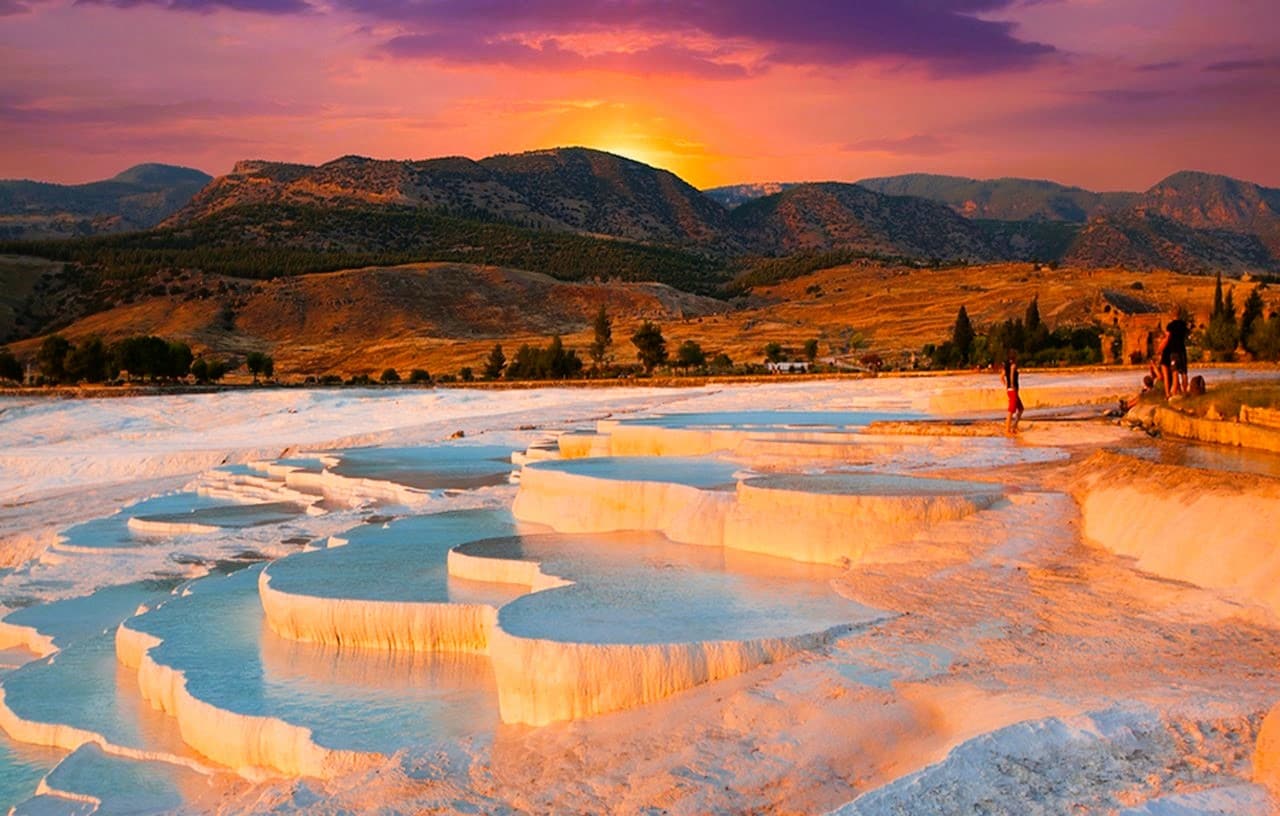
Pamukkale is a natural wonder located in the Denizli Province of southwestern Turkey. It is known for its white travertine terraces, which are formed by mineral-rich hot springs that cascade down the hillside. The terraces resemble frozen waterfalls and are a popular tourist attraction.
In addition to the terraces, Pamukkale is also home to the ancient city of Hierapolis, which was founded in the 2nd century BC. The ruins of Hierapolis include a well-preserved theatre, a necropolis, and a variety of other ancient structures.
Visitors to Pamukkale can enjoy a range of activities, including soaking in the hot springs, hiking along the terraces, exploring the ancient ruins of Hierapolis, and taking in the stunning views of the surrounding countryside.
The best time to visit Pamukkale is in the spring or fall, when the weather is mild and the crowds are smaller. However, the hot springs are open year-round, so visitors can enjoy them at any time of the year.
Pamukkale is located about 3 hours from Antalya by car, or about 4 hours by bus. Many tour operators offer day trips from Antalya to Pamukkale, or visitors can choose to stay overnight in one of the nearby hotels.
Ephesus
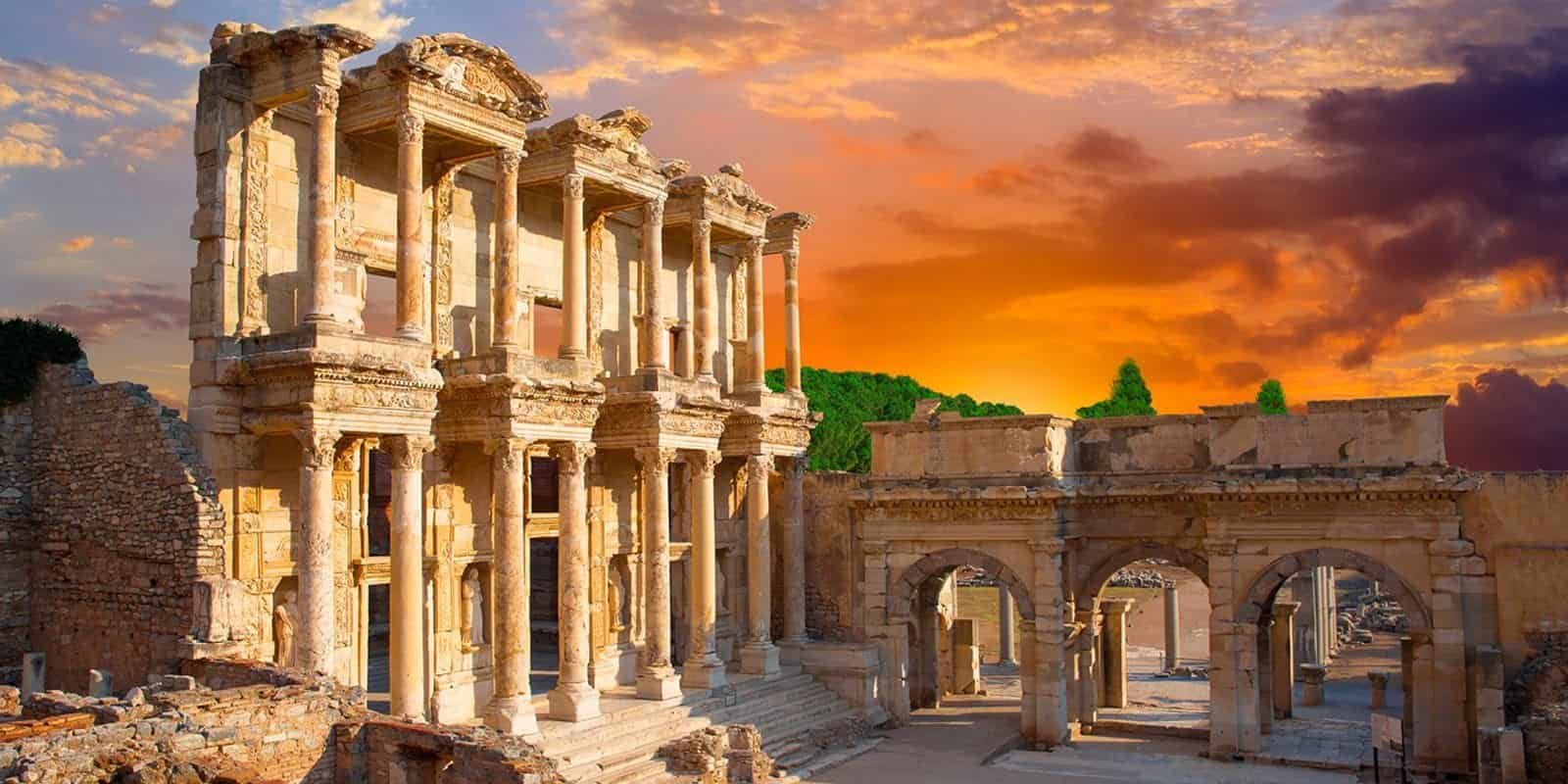
Ephesus was an ancient Greek city located in western Anatolia, near the present-day town of Selçuk in Turkey. It was one of the largest and most important cities in the ancient world and was home to the famous Temple of Artemis, one of the Seven Wonders of the Ancient World. Today, the ruins of Ephesus are a popular tourist destination and a UNESCO World Heritage Site, attracting visitors from all over the world.
The city was founded in the 10th century BC by Ionian Greeks, and it became an important centre of trade and culture during the Hellenistic and Roman periods. It was home to some of the most famous philosophers, scientists, and writers of the ancient world, including Heraclitus, the philosopher who famously said, "You cannot step into the same river twice."
Ephesus was also an important centre of early Christianity, and the Apostle Paul is said to have spent time there during his missionary journeys. The city was home to one of the seven churches of Asia mentioned in the Book of Revelation, and it was the site of the Council of Ephesus in AD 431, which affirmed the doctrine of the Virgin Mary's divine motherhood.
Today, visitors to Ephesus can explore the ruins of the ancient city, including the famous Library of Celsus, the Great Theater, and the Temple of Hadrian. There is also a museum on site that houses artefacts and exhibits related to the history of the city.
Bodrum

Bodrum is a beautiful coastal city located in the southwestern part of Turkey. It is known for its stunning beaches, crystal-clear waters, ancient ruins, and vibrant nightlife. Here is some in-depth information about Bodrum:
Geography and Climate: Bodrum is located on the Bodrum Peninsula, which is situated between the Aegean and the Mediterranean Seas. The city is surrounded by hills and has a rocky coastline with numerous bays and coves. The climate in Bodrum is Mediterranean, with hot and dry summers and mild winters.
History: Bodrum has a rich history that dates back to ancient times. It was once known as Halicarnassus, a city founded by the Greeks in the 5th century BC. Halicarnassus was later conquered by the Romans and became an important centre of trade and commerce. The city was also the birthplace of the famous historian Herodotus.
In the Middle Ages, Bodrum was ruled by the Knights of St. John, who built the famous Bodrum Castle, one of the city's most iconic landmarks. The castle was built in the 15th century and is now home to the Museum of Underwater Archaeology.
Trabzon

Trabzon is a city located on the Black Sea coast in the northeast region of Turkey. It is the largest city in the eastern Black Sea region and serves as an important economic, cultural, and transportation hub for the area. Here are some more details about Trabzon:
- History: Trabzon has a long and rich history, with evidence of settlement dating back to the 8th century BC. The city has been ruled by various empires throughout history, including the Greeks, Romans, Byzantines, and Ottomans.
- Landmarks: Trabzon is home to many historic landmarks, including the Hagia Sophia Museum, a former Byzantine church that dates back to the 13th century; the Ataturk Pavilion, a historic mansion that served as a residence for Ataturk, the founder of modern Turkey; and the Trabzon Castle, a Byzantine-era fortress that overlooks the city.
- Cuisine: Trabzon is known for its unique cuisine, which features a mix of local and Ottoman influences. Some popular dishes include hamsi (fried anchovies), kuymak (a type of cheese fondue), and pide (Turkish pizza).
- Natural Beauty: Trabzon is surrounded by stunning natural beauty, including the Pontic Mountains and the Black Sea coast. There are many hiking and trekking opportunities in the area, as well as beaches and seaside resorts.
- Culture: Trabzon has a rich cultural heritage, with a unique blend of Turkish, Greek, and Georgian influences. The city is known for its traditional music, dance, and art, as well as its festivals and celebrations, such as the Trabzon International Black Sea Festival.
- Education: Trabzon is home to several universities, including Karadeniz Technical University, which is one of the largest and most prestigious universities in Turkey. The city also has a vibrant student population, with many cultural and recreational activities available for young people.
- Sports: Trabzon is a hub for sports in the Black Sea region, with a strong tradition in football (soccer) and basketball. The city is home to several professional sports teams, including Trabzonspor, one of the most successful football clubs in Turkey.
- Transportation: Trabzon has a modern transportation system, with an international airport, a seaport, and a well-developed road network. The city is also a major stop on the Black Sea coastal highway, which connects Turkey to the countries of the Caucasus and Central Asia.
Goreme
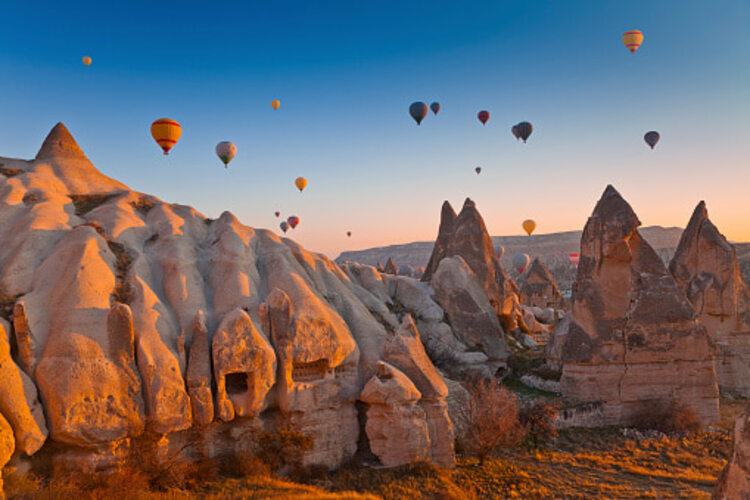
Goreme is a small town located in the Cappadocia region of Turkey, known for its unique landscape of fairy chimneys and rock formations. The town is a popular tourist destination, attracting visitors from all over the world who come to explore the fascinating history and natural beauty of the region.
One of the main attractions in Goreme is the Goreme Open-Air Museum, a UNESCO World Heritage Site featuring ancient rock churches and monasteries. These churches were carved into the soft volcanic rock by early Christians during the Byzantine era, and many still contain stunning frescoes and other works of art.
Another popular attraction in Goreme is the Kaymakli Underground City, an ancient underground city that was used as a shelter by early Christians. The city features a complex network of tunnels and rooms, and visitors can explore some of the lower levels of the city to get a glimpse into what life was like during the Byzantine era.
Goreme is also known for its unique accommodations, with many hotels and guesthouses built into the caves and rock formations of the region. These cave hotels offer a truly unique experience and are a popular choice among visitors to the area.
Other popular activities in Goreme include taking a hot air balloon ride to see the unique landscape from above, hiking through the Red Valley to enjoy stunning views of the rock formations, and visiting the Avanos Pottery Workshop to watch local artisans at work.
Goreme is also known for its local cuisine, including traditional dishes like Testi Kebab and Cappadocian wine, which can be found at local restaurants and cafes. Overall, Goreme is a fascinating destination for anyone interested in history, nature, and culture, with plenty to see and do for visitors of all ages and interests.
Fethiye
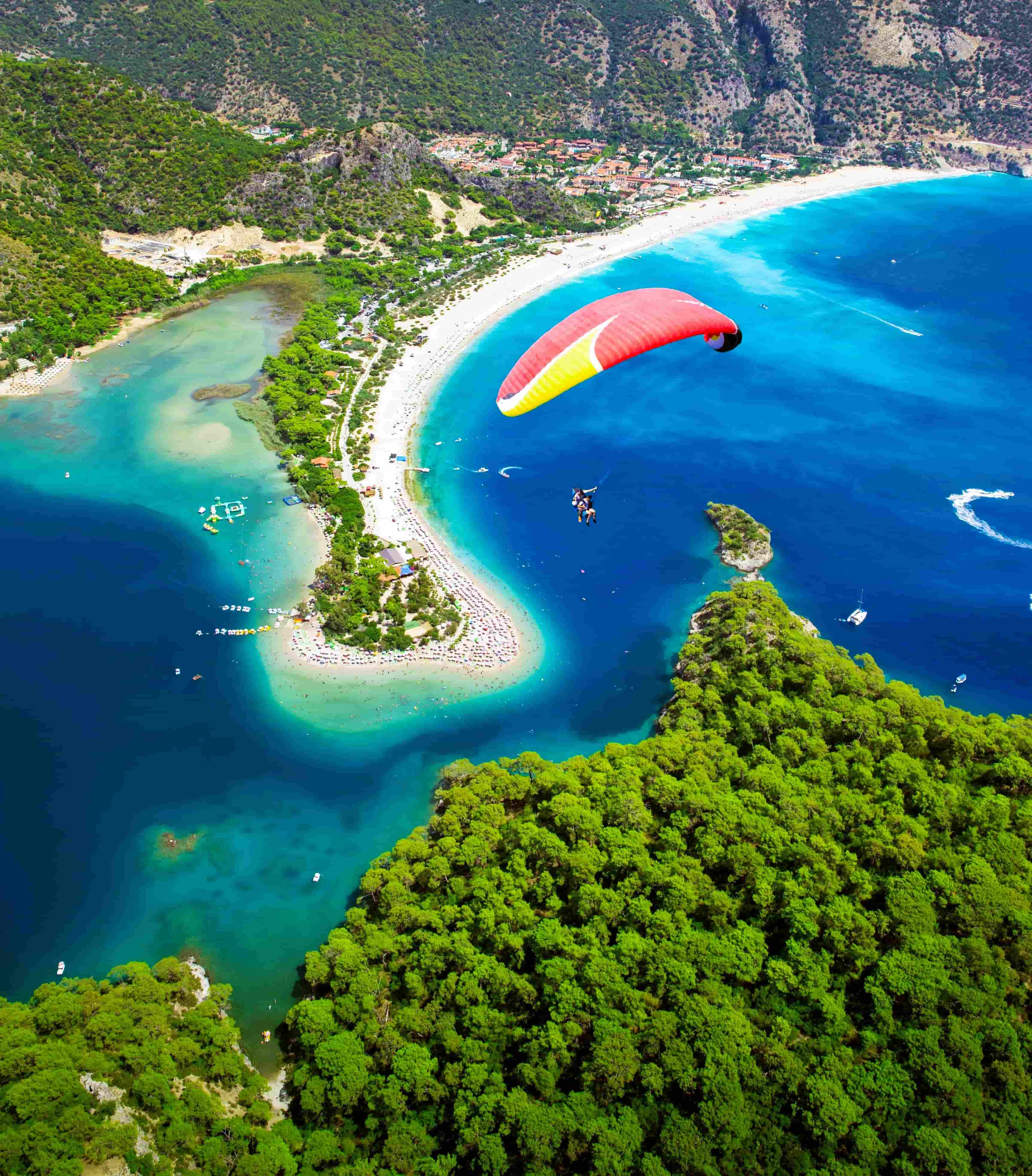
Fethiye is a city and district of Muğla Province in the Mediterranean Region of Turkey. It is one of the prominent tourist destinations in the Turkish Riviera. In 2019 its population was 162,686.
Fethiye is located on the Aegean Sea, about 135 kilometres (84 mi) southwest of Antalya. The city is surrounded by mountains, and it has a coastline of about 140 kilometres (87 mi). Fethiye is home to a number of historical and cultural sites, including:
- The Tlos Ancient City: This ancient city was founded by the Lycians in the 2nd millennium BC.
- The Saklikent Gorge: This gorge is one of the deepest in Turkey, and it is a popular destination for hiking and canyoning.
- The Butterfly Valley: This valley is home to a variety of butterflies, and it is a popular destination for swimming, sunbathing, and camping.
- The Oludeniz Blue Lagoon: This lagoon is one of the most popular tourist destinations in Turkey, and it is known for its clear turquoise water.
Fethiye is a popular tourist destination, and it offers a variety of activities and attractions for visitors. The city is home to a number of hotels, restaurants, and bars, and it has a vibrant nightlife. Fethiye is also a popular destination for water sports, such as swimming, sunbathing, sailing, windsurfing, and diving.
If you are looking for a relaxing beach vacation or an active holiday, Fethiye is a great option. The city has something to offer everyone, and you are sure to have a memorable trip.
Konya
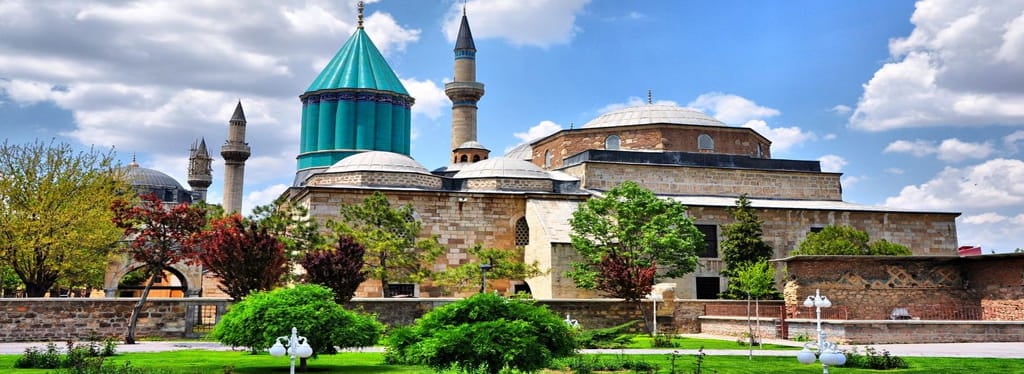
Konya is a city in central Turkey. It is the capital of Konya Province and the seventh most populous city in Turkey. The city is located in the Central Anatolian Plateau, about 300 kilometres (186 miles) south of Ankara.
Konya has a long and rich history. It was founded by the Hittites in the 2nd millennium BC and was later ruled by the Phrygians, Lydians, Persians, Greeks, Romans, Byzantines, and Seljuk Turks. In the 13th century, Konya became the capital of the Seljuk Sultanate of Rum.
Konya is home to a number of historical and cultural sites, including
- The Mevlana Museum: This museum is dedicated to the Sufi mystic Mevlana Celaleddin Rumi, who founded the Mevlevi order of whirling dervishes.
- The Alaeddin Mosque: This mosque was built in the 13th century by the Seljuk Sultan Alaeddin Keykubad I.
- The Sille Archaeological Site: This site is home to the ruins of an ancient city that was once a major center of Christianity.
- The Konya Archaeological Museum: This museum houses a collection of artifacts from the region's history, including Roman, Byzantine, and Seljuk artifacts.
Konya is also a major center for Islamic learning. It is home to the Seljuk University, one of the oldest universities in Turkey.
Konya is a vibrant and cosmopolitan city with a rich history and culture. It is a great place to visit for those interested in learning more about Turkey's past and present.
Ankara
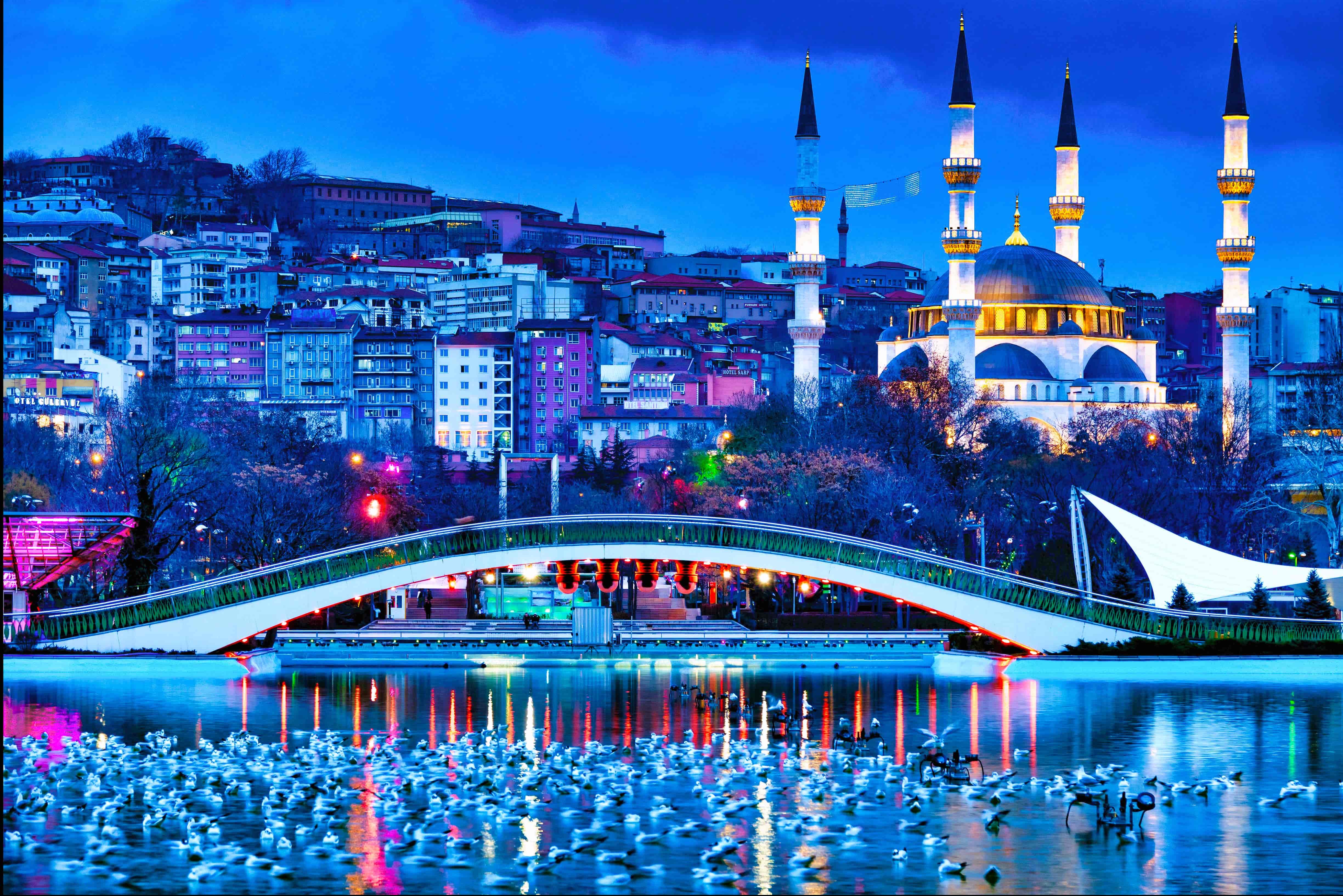
Ankara is the capital of Turkey. It is the second-most populous city in Turkey, after Istanbul. Ankara is located in the central part of the country, in the Anatolian Plateau.
Ankara has a long and rich history. It was founded by the Hittites in the 2nd millennium BC. Ankara was later ruled by the Phrygians, Lydians, Persians, Greeks, Romans, Byzantines, and Ottomans. In 1923, Ankara was chosen to be the capital of the Republic of Turkey.
Ankara is a modern city with a mix of old and new. The city is home to a number of historical and cultural sites, including:
- The Anıtkabir: This is the mausoleum of Mustafa Kemal Atatürk, the founder of the Republic of Turkey.
- The Roman Baths: These baths were built in the 2nd century AD.
- The Ankara Castle: This castle was built in the 13th century.
- The Ethnography Museum: This museum houses a collection of artifacts from the region's history.
- The Anatolian Civilizations Museum: This museum houses a collection of artifacts from the region's history, including Hittite, Phrygian, Lydian, Persian, Greek, Roman, Byzantine, and Ottoman artifacts.
Ankara is also a major center for business and government. The city is home to the headquarters of many Turkish companies and government agencies. Ankara is also home to a number of universities, including the Middle East Technical University and the Ankara University.
Ankara is a vibrant and cosmopolitan city with a rich history and culture. It is a great place to visit for those interested in learning more about Turkey's past and present.
Izmir
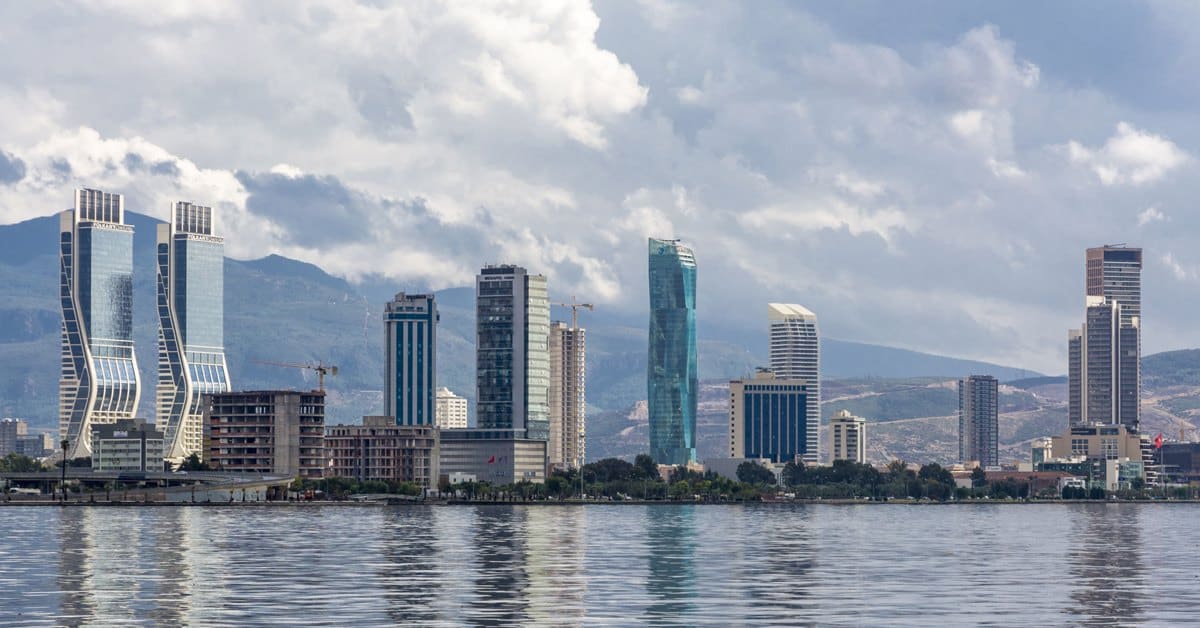
Izmir is a metropolitan city on the west coast of Anatolia, and capital of İzmir Province. It is the third most populous city in Turkey, after Istanbul and Ankara, and the largest urban agglomeration on the Aegean Sea.
Izmir has a long and rich history. It was founded by the ancient Greeks in the 10th century BC and was later ruled by the Romans, Byzantines, Ottomans, and finally the Turks. The city has a number of historical and cultural sites, including:
- The Kadifekale: This is a hilltop castle that was built by the Byzantines in the 5th century AD.
- The İzmir Clock Tower: This clock tower was built in the 19th century by the Ottoman Sultan Abdülmecid I.
- The Konak Pier: This pier was built in the 19th century and is a popular spot for fishing and watching the sunset.
- The İzmir Museum of Archaeology: This museum houses a collection of artifacts from the region's history, including Roman, Byzantine, and Ottoman artifacts.
- The İzmir Ethnography Museum: This museum houses a collection of artifacts from the region's culture, including clothing, jewelry, and musical instruments.
Izmir is also a major center for business and industry. The city is home to the headquarters of many Turkish companies and is a major port city. Izmir is also a popular tourist destination, and is known for its beautiful beaches, clear waters, and lively nightlife.
Bursa
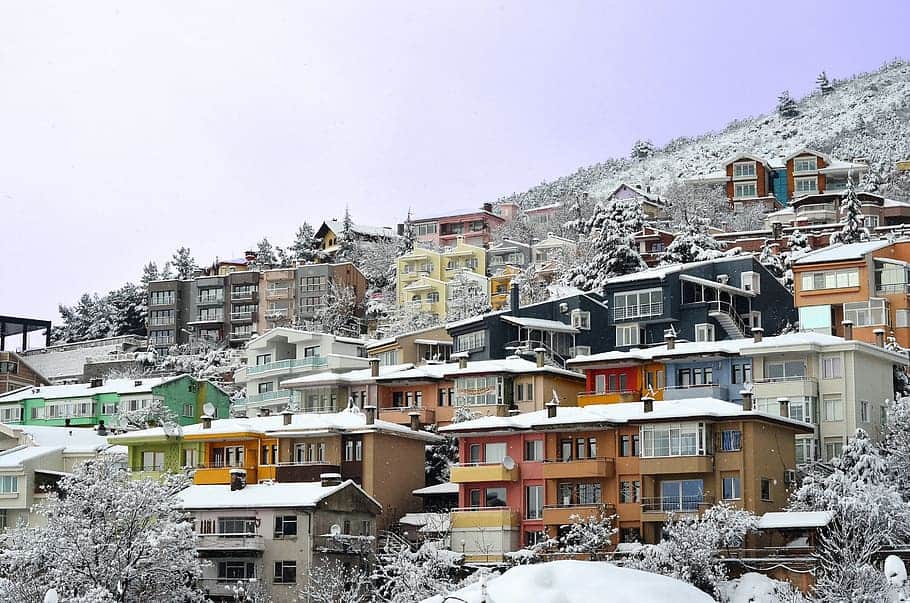
Bursa is a city in northwestern Turkey and the administrative center of Bursa Province. The fourth-most populous city in Turkey and second-most populous in the Marmara Region, Bursa is one of the industrial centers of the country. Most of Turkey's automotive production takes place in Bursa.
Bursa was founded by the ancient Greeks in the 7th century BC. It was later ruled by the Romans, Byzantines, Ottomans, and finally the Turks. The town has a long and rich history, and it is home to a number of historical and cultural sites.
The Green Tomb (Turkish: Yeşil Türbe) is one of the most famous historical sites in Bursa. It was built in the 14th century by the Ottoman Sultan Mehmed I. The tomb is decorated with beautiful tiles and is a popular tourist destination.
The Grand Mosque (Turkish: Ulu Cami) is another important historical site in Bursa. It was built in the 14th century by the Ottoman Sultan Bayezid I. The mosque is one of the largest in Turkey and is a popular place of worship for Muslims.
The Koza Han is a historic caravanserai that was built in the 14th century by the Ottoman Sultan Murad I. The caravanserai is now a museum and is a popular tourist destination.
Bursa is also home to a number of natural attractions. Uludağ is a mountain located near Bursa and is a popular destination for skiing and snowboarding. The İnegöl Kaplıcaları are hot springs located near the city of İnegöl and are a popular destination for people seeking relaxation and healing.
Bursa is a vibrant and cosmopolitan city with a rich history and culture. It is a great place to visit for those interested in learning more about Turkey's past and present.
Edirne
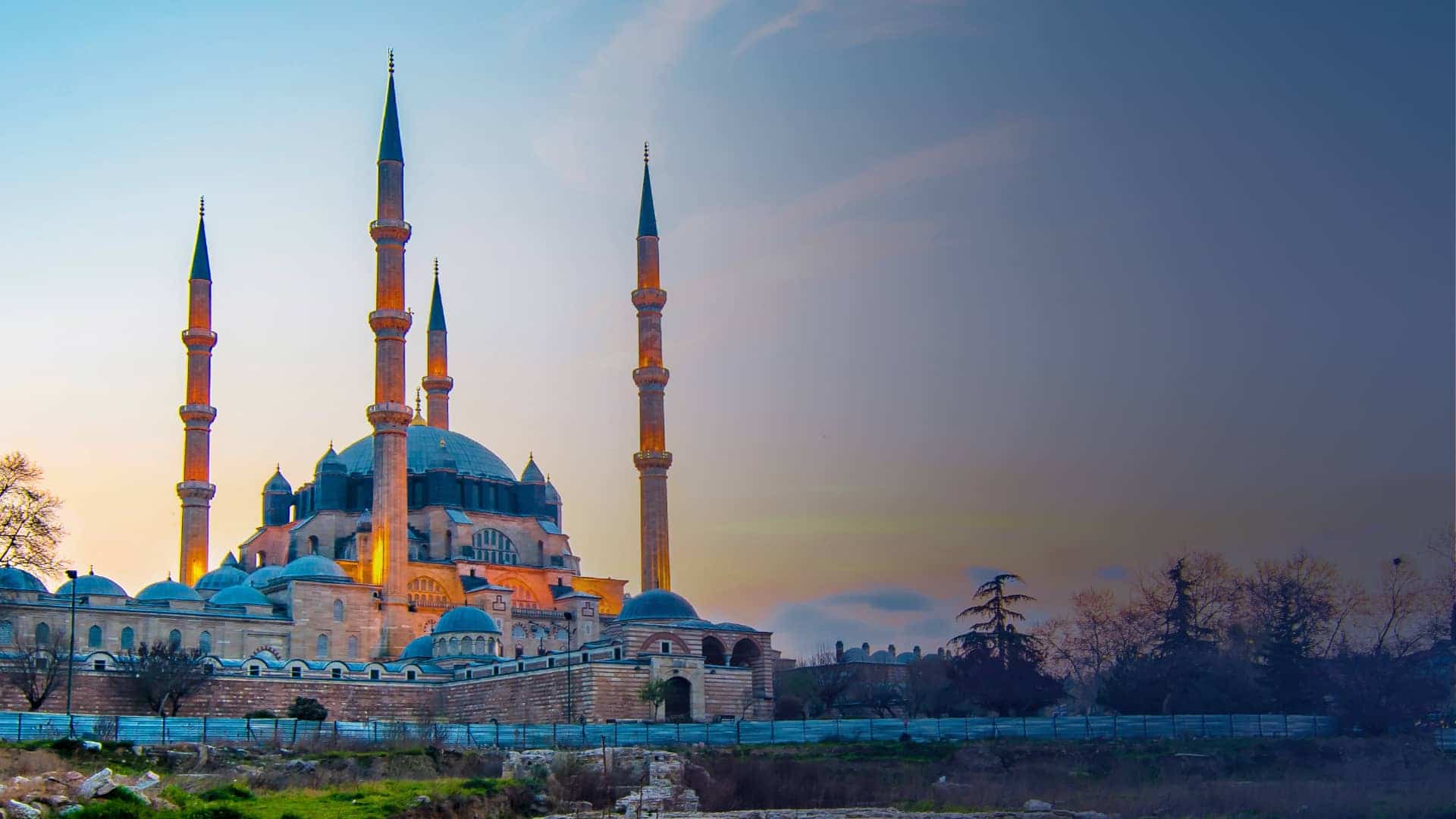
Edirne is a city in Turkey, in the northwestern part of the province of Edirne in Eastern Thrace. Situated 7 km (4.3 mi) from the Greek and 20 km (12 mi) from the Bulgarian borders, Edirne was the second capital city of the Ottoman Empire from 1369 to 1453, before Constantinople became its capital.
Edirne has a long and rich history dating back to the 6th century BC. It was founded by the Thracians and later conquered by the Romans, Byzantines, and Ottomans. The city is home to many historical and cultural monuments, including the Selimiye Mosque, the Üç Şerefeli Mosque, and the Edirne Fortress.
Edirne is a major economic center in Turkey. It is a major center for trade, manufacturing, and tourism. The city is also home to a number of universities and colleges.
Edirne is a popular tourist destination. The city is known for its beautiful mosques, palaces, and other historical monuments. Edirne is also a popular destination for shopping and dining.
Here are some interesting facts about Edirne:
- Edirne was the capital of the Ottoman Empire for 84 years.
- The Selimiye Mosque, one of the most famous mosques in the world, is located in Edirne.
- Edirne is home to a number of historical monuments, including the Üç Şerefeli Mosque, the Edirne Fortress, and the Eski Mosque.
- Edirne is a major economic center in Turkey.
Marmaris

Marmaris is a resort town on the Mediterranean coast of Turkey, in Muğla Province. It is one of the most popular tourist destinations in Turkey, and is known for its beautiful beaches, clear waters, and lively nightlife.
Marmaris is located on a peninsula, and is surrounded by mountains and forests. The town has a long history, dating back to the ancient Greeks and Romans. In the 16th century, it was conquered by the Ottoman Empire, and became an important trade center.
Today, Marmaris is a popular destination for both domestic and international tourists. The town has a wide range of accommodation options, from luxury hotels to budget-friendly hostels. There are also plenty of things to do in Marmaris, including swimming, sunbathing, boating, fishing, and hiking.
Gallipoli
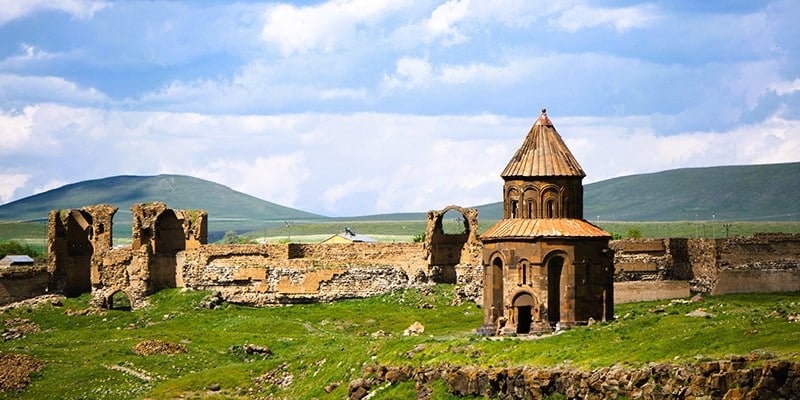
Gallipoli is a peninsula in northwestern Turkey, located in the Dardanelles Strait. It is known for its role in the Gallipoli Campaign of World War I, in which Allied forces attempted to capture the Ottoman capital of Constantinople (now Istanbul). The campaign was a failure, but it is remembered as a defining moment in the history of Australia and New Zealand.
The Gallipoli Peninsula is about 60 kilometers long and 10 kilometers wide. It is bordered by the Aegean Sea to the west and the Dardanelles Strait to the east. The peninsula is home to a variety of landscapes, including mountains, forests, and beaches.
The Gallipoli Campaign was launched by the Allies in April 1915. The goal of the campaign was to capture Constantinople and knock the Ottoman Empire out of the war. The Allies landed troops at five beaches on the Gallipoli Peninsula: ANZAC Cove, Helles, Suvla Bay, and two beaches at Cape Helles.
The campaign was a failure. The Allies were unable to capture Constantinople and they suffered heavy casualties. The campaign ended in January 1916 with the evacuation of Allied troops from the peninsula.
The Gallipoli Campaign is remembered as a defining moment in the history of Australia and New Zealand. The campaign was the first major military operation for both countries and it resulted in the deaths of over 8,000 Australians and over 2,700 New Zealanders. The campaign also helped to forge a strong bond between Australia and New Zealand, which is known as the Anzac spirit.
Today, Gallipoli is a popular tourist destination. The peninsula is home to a number of historical sites, including the ANZAC Cove Cemetery and Memorial, the Helles Memorial, and the Suvla Bay Cemetery. The Gallipoli Campaign is also commemorated on Anzac Day, which is a public holiday in Australia and New Zealand on April 25.
Ani

Ani is an abandoned medieval Armenian city in the Kars Province of eastern Turkey. It is located on a plateau overlooking the Arpaçay River, near the border with Armenia. Ani was founded in the 5th century AD and became one of the most important cities in the Armenian Kingdom of Bagratuni. It reached its peak in the 11th and 12th centuries, when it was the capital of the Bagratuni Kingdom of Armenia. Ani was a major center of trade, culture, and art, and it was home to a number of important churches, monasteries, and palaces.
Ani was sacked by the Seljuk Turks in 1064 and was later conquered by the Mongols in 1236. The city was abandoned in the 17th century after it was repeatedly attacked by invaders. Today, Ani is a UNESCO World Heritage Site and is one of the most important archaeological sites in Turkey.
The ruins of Ani are spread over a large area and include a number of important monuments, including:
- The Cathedral of Ani: This 11th-century cathedral is one of the largest and most impressive churches in Armenia.
- The Church of the Redeemer: This 11th-century church is known for its intricate stone carvings.
- The Church of the Holy Cross: This 12th-century church is located on a hilltop overlooking the city.
- The Palace of the Bagratuni Kings: This 11th-century palace was the seat of the Bagratuni kings of Armenia.
- The Bridge of Ani: This 11th-century bridge is one of the oldest and most important bridges in Turkey.
Ani is a fascinating and important archaeological site that offers a glimpse into the history and culture of Armenia. The ruins of the city are a testament to the power and influence of the Armenian Kingdom of Bagratuni. Ani is a UNESCO World Heritage Site and is a popular tourist destination.
Mount Nemru
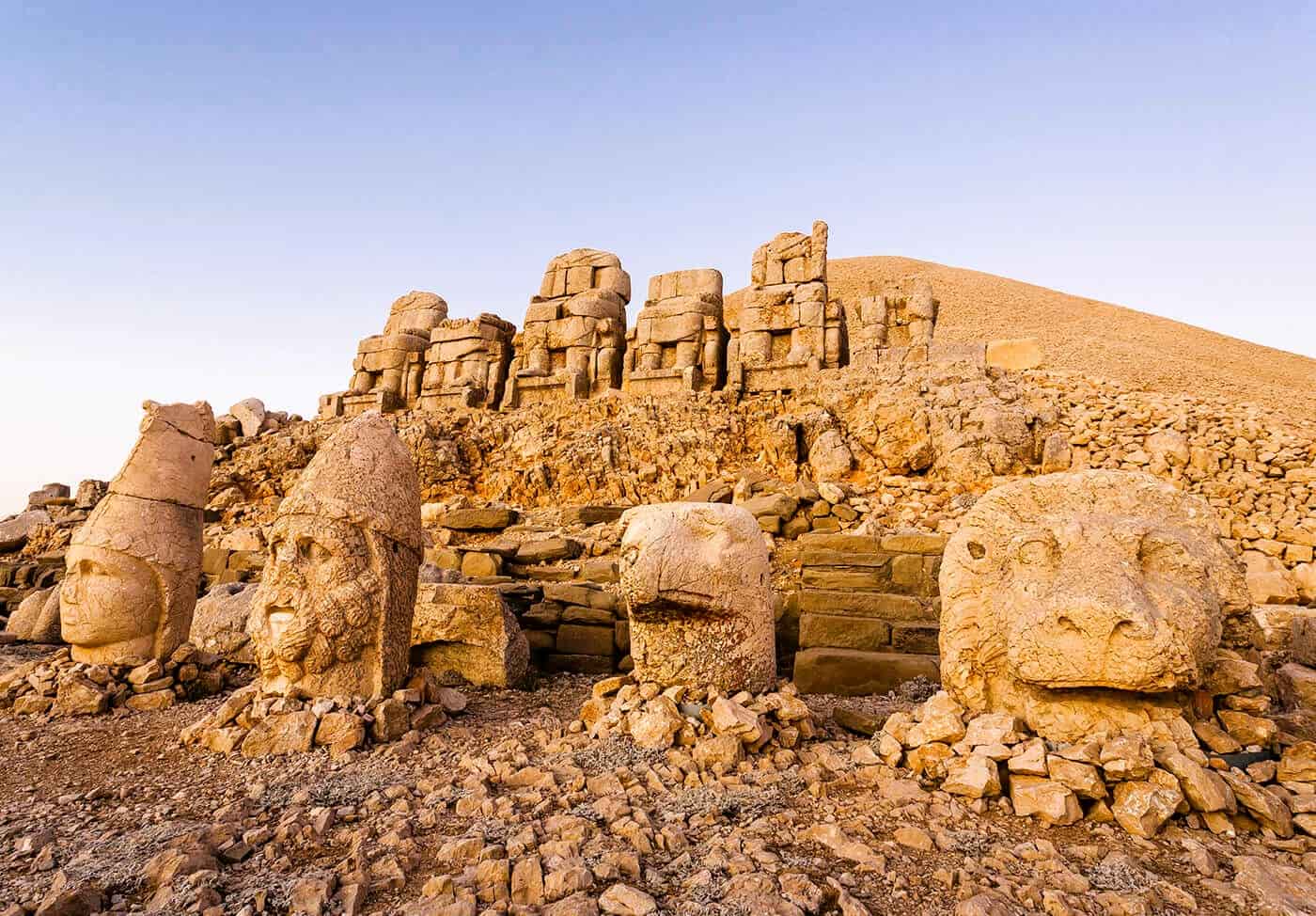
Mount Nemrut (Turkish: Nemrut Dağı; Kurdish: Çiyayê Nemrûdê; Armenian: Նեմրութ լեռ; Greek: Όρος Νεμρούτ) is a 2,134-metre-high (7,001 ft) mountain in southeastern Turkey, notable for the summit where a number of large statues are erected around what is assumed to be a royal tomb from the 1st century BC. It is one of the highest peaks in the east of the Taurus Mountains.
The mountain lies 40 km (25 mi) north of Kahta, near Adıyaman. In 62 BC, King Antiochus I of Commagene built on the mountain top a tomb-sanctuary flanked by huge statues 8–9-metre high (26–30 ft) of himself, two lions, two eagles, and various composite Greek and Iranian gods, such as Heracles-Artagnes-Ares, Zeus-Oromasdes, and Apollo-Mithras-Helios-Hermes.
The sanctuary was built in a syncretic style, combining Greek, Persian, and Anatolian elements. The statues are all facing east, towards the rising sun. The sanctuary was abandoned after the death of Antiochus I, and it was not rediscovered until the 19th century.
Mount Nemrut is a UNESCO World Heritage Site and is a popular tourist destination. The sanctuary is a unique and impressive example of ancient architecture, and the views from the summit are breathtaking.
Safranbolu
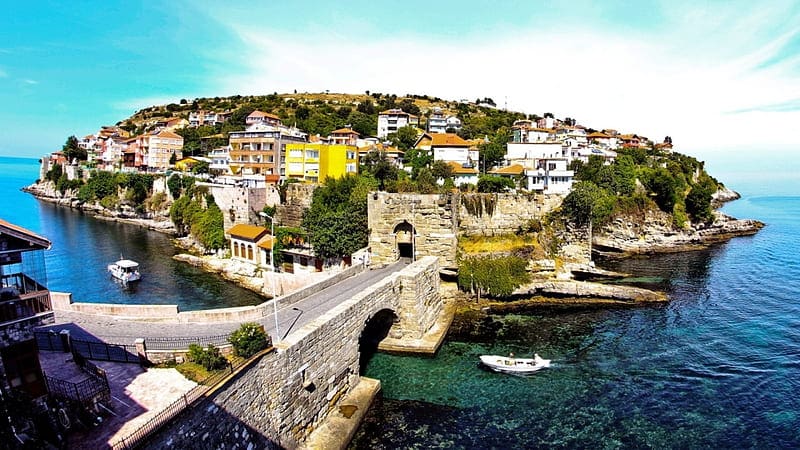
Safranbolu is a town in Karabük Province in the Black Sea region of Turkey. It is the seat of Safranbolu District. Its population is 52,999 (2022). It is about 9 km north of the city of Karabük, 200 kilometres (120 mi) north of Ankara and about 100 km south of the Black Sea coast. The town's historic names in Greek were Theodoroupolis (Θεοδωρούπολις, i.e. city of Theodorus or female Theodora) and later Saframpolis (Σαφράμπολις).
Its former names in Turkish were Zalifre and Taraklıborlu. It was part of Kastamonu Province until 1923 and Zonguldak Province between 1923 and 1995. The town lies at an elevation of 508 m (1,667 ft).
The town is known for its well-preserved Ottoman architecture, including houses, mosques, and hans (inns). Safranbolu was added to the UNESCO World Heritage List in 1994.
The town is also known for its production of saffron, a spice made from the stigmas of the saffron crocus. Safranbolu is the largest producer of saffron in Turkey.
Safranbolu is a popular tourist destination. The town is known for its historic atmosphere and its traditional crafts. Safranbolu is also a good base for exploring the surrounding countryside.
Selcuk
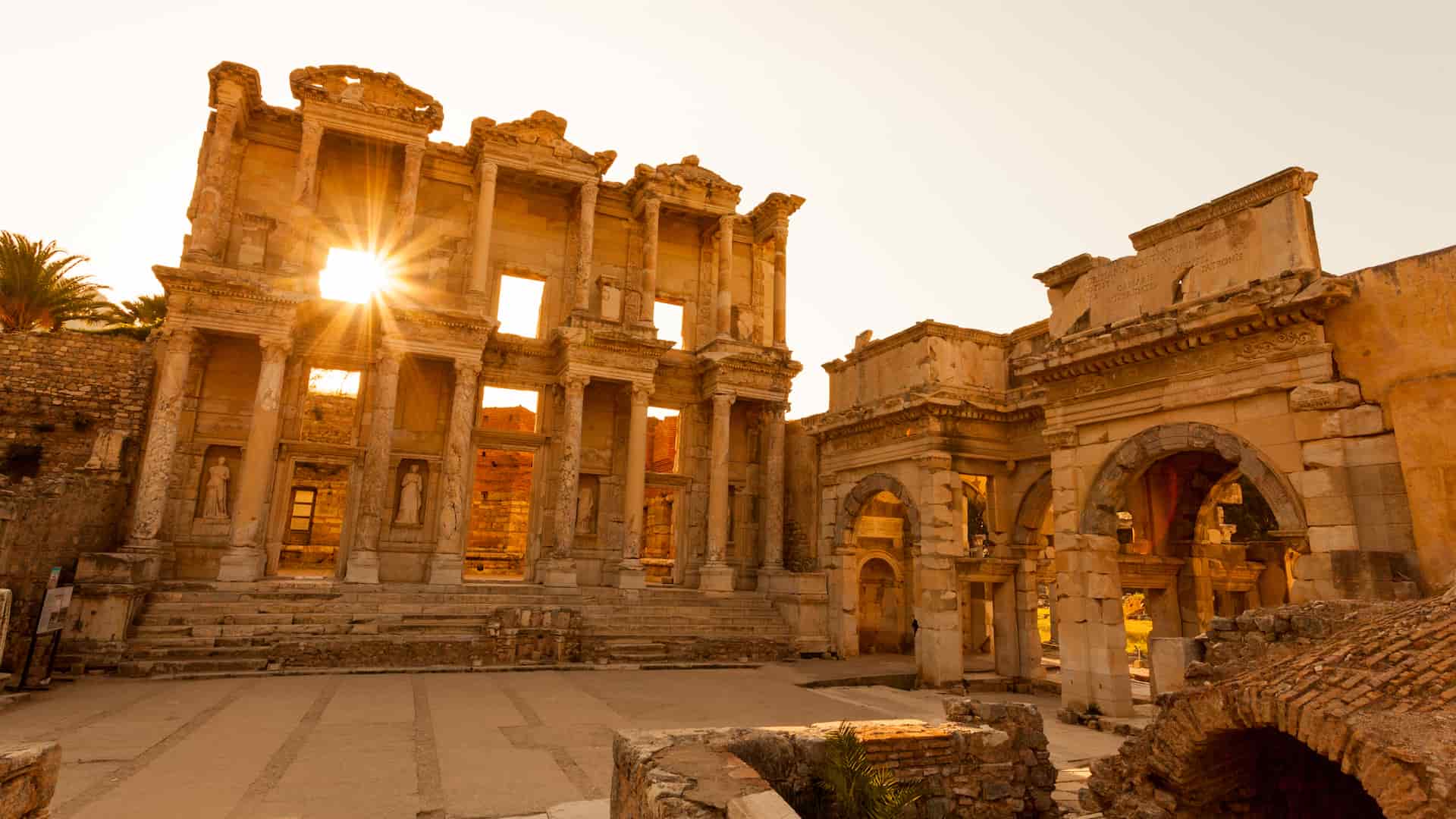
Selçuk is a town in Turkey, in the northwestern part of the province of İzmir in Eastern Thrace. Situated 7 km (4.3 mi) from the Greek and 20 km (12 mi) from the Bulgarian borders, Selçuk was the second capital city of the Ottoman Empire from 1369 to 1453, before Constantinople became its capital.
Selçuk has a long and rich history dating back to the 6th century BC. It was founded by the Thracians and later conquered by the Romans, Byzantines, and Ottomans. The city is home to many historical and cultural monuments, including the Selimiye Mosque, the Üç Şerefeli Mosque, and the Edirne Fortress.
Selçuk is a major economic center in Turkey. It is a major center for trade, manufacturing, and tourism. The city is also home to a number of universities and colleges.
Selçuk is a popular tourist destination. The city is known for its beautiful mosques, palaces, and other historical monuments. Selçuk is also a popular destination for shopping and dining.
